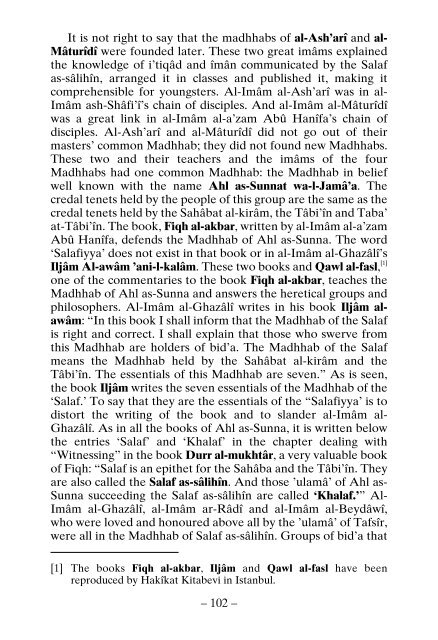Belief and Islam
BELIEF AND ISLAM star This work, Belief and Islam, originally was written in Persian under the title I’tiqâd-nâma by Hadrât Mawlânâ Khâlid al-Baghdâdî, a profound ‘âlim of Islam and a specialist in ma’ârif of tasawwuf. Hâji Faydullah Effendi of Kemah, a khalîfa of great walî Mavlânâ Mahmûd Sâhib, the brother of the author, translated the book into Turkish and named it Farâid-ul-fawâid which was printed in Istanbul in 1312 A.H.[1894]. Our bookstore had it translated again from the Persian original into Turkish and, some explanations and three chapters, published it with the title Imân ve Islâm in 1966. German, French and Arabic versions are also published by our bookstore. This book, explains five fundamentals of Islam, six fundamentals of îmân and the contemporary information about the matter and refutes those who are against Islam and those who are lâ-madbhabî.
BELIEF AND ISLAM
star This work, Belief and Islam, originally was written in Persian under the title I’tiqâd-nâma by Hadrât Mawlânâ Khâlid al-Baghdâdî, a profound ‘âlim of Islam and a specialist in ma’ârif of tasawwuf. Hâji Faydullah Effendi of Kemah, a khalîfa of great walî Mavlânâ Mahmûd Sâhib, the brother of the author, translated the book into Turkish and named it Farâid-ul-fawâid which was printed in Istanbul in 1312 A.H.[1894]. Our bookstore had it translated again from the Persian original into Turkish and, some explanations and three chapters, published it with the title Imân ve Islâm in 1966. German, French and Arabic versions are also published by our bookstore. This book, explains five fundamentals of Islam, six fundamentals of îmân and the contemporary information about the matter and refutes those who are against Islam and those who are lâ-madbhabî.
Create successful ePaper yourself
Turn your PDF publications into a flip-book with our unique Google optimized e-Paper software.
It is not right to say that the madhhabs of al-Ash’arî <strong>and</strong> al-<br />
Mâturîdî were founded later. These two great imâms explained<br />
the knowledge of i’tiqâd <strong>and</strong> îmân communicated by the Salaf<br />
as-sâlihîn, arranged it in classes <strong>and</strong> published it, making it<br />
comprehensible for youngsters. Al-Imâm al-Ash’arî was in al-<br />
Imâm ash-Shâfi’î’s chain of disciples. And al-Imâm al-Mâturîdî<br />
was a great link in al-Imâm al-a’zam Abû Hanîfa’s chain of<br />
disciples. Al-Ash’arî <strong>and</strong> al-Mâturîdî did not go out of their<br />
masters’ common Madhhab; they did not found new Madhhabs.<br />
These two <strong>and</strong> their teachers <strong>and</strong> the imâms of the four<br />
Madhhabs had one common Madhhab: the Madhhab in belief<br />
well known with the name Ahl as-Sunnat wa-l-Jamâ’a. The<br />
credal tenets held by the people of this group are the same as the<br />
credal tenets held by the Sahâbat al-kirâm, the Tâbi’în <strong>and</strong> Taba’<br />
at-Tâbi’în. The book, Fiqh al-akbar, written by al-Imâm al-a’zam<br />
Abû Hanîfa, defends the Madhhab of Ahl as-Sunna. The word<br />
‘Salafiyya’ does not exist in that book or in al-Imâm al-Ghazâlî’s<br />
Iljâm Al-awâm ’ani-l-kalâm. These two books <strong>and</strong> Qawl al-fasl, [1]<br />
one of the commentaries to the book Fiqh al-akbar, teaches the<br />
Madhhab of Ahl as-Sunna <strong>and</strong> answers the heretical groups <strong>and</strong><br />
philosophers. Al-Imâm al-Ghazâlî writes in his book Iljâm alawâm:<br />
“In this book I shall inform that the Madhhab of the Salaf<br />
is right <strong>and</strong> correct. I shall explain that those who swerve from<br />
this Madhhab are holders of bid’a. The Madhhab of the Salaf<br />
means the Madhhab held by the Sahâbat al-kirâm <strong>and</strong> the<br />
Tâbi’în. The essentials of this Madhhab are seven.” As is seen,<br />
the book Iljâm writes the seven essentials of the Madhhab of the<br />
‘Salaf.’ To say that they are the essentials of the “Salafiyya’ is to<br />
distort the writing of the book <strong>and</strong> to sl<strong>and</strong>er al-Imâm al-<br />
Ghazâlî. As in all the books of Ahl as-Sunna, it is written below<br />
the entries ‘Salaf’ <strong>and</strong> ‘Khalaf’ in the chapter dealing with<br />
“Witnessing” in the book Durr al-mukhtâr, a very valuable book<br />
of Fiqh: “Salaf is an epithet for the Sahâba <strong>and</strong> the Tâbi’în. They<br />
are also called the Salaf as-sâlihîn. And those ’ulamâ’ of Ahl as-<br />
Sunna succeeding the Salaf as-sâlihîn are called ‘Khalaf.’” Al-<br />
Imâm al-Ghazâlî, al-Imâm ar-Râdî <strong>and</strong> al-Imâm al-Beydâwî,<br />
who were loved <strong>and</strong> honoured above all by the ’ulamâ’ of Tafsîr,<br />
were all in the Madhhab of Salaf as-sâlihîn. Groups of bid’a that<br />
[1] The books Fiqh al-akbar, Iljâm <strong>and</strong> Qawl al-fasl have been<br />
reproduced by Hakîkat Kitabevi in Istanbul.<br />
– 102 –

















